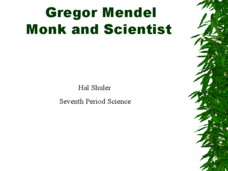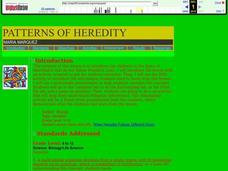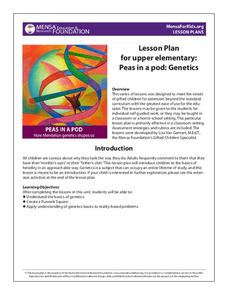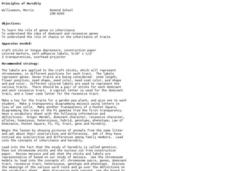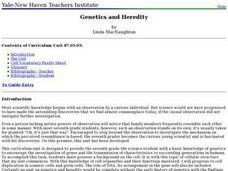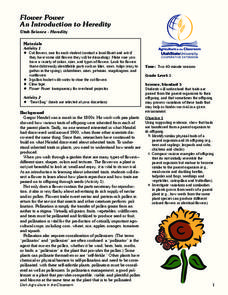Curated OER
Gregor Mendel: Monk and Scientist
This is a visually attractive PowerPoint that summarizes the life of Gregor Mendel and the genetic traits that he detailed. Each slide has clear bullet points and lovely images that are helpful and relevant
Curated OER
Genetics and the Work of Mendel
Excellent examples and clear diagrams in this PowerPoint will help you explain the genetics of alleles and the combinations of hybrid crosses. A high school class would appreciate having this student copy of the PowerPoint as the images...
Curated OER
Mendel's Laws of Heredity
Easy-to-read notes about Mendel's Laws of Heredity make up this collection of slides. In bullet-point style, viewers are exposed to Mendel's pea plant experimentation and the rules he developed that govern genetics. There are no graphics...
Curated OER
Genetics and The Work of Mendel
If you need a summary of all aspects of Mendelian genetics then this slideshow is for you. The information included is essential for complete understanding of crosses, genotypes, phenotypes, and heredity.
Curated OER
Gregor Mendel
There are only five slides in this collection. They will not support an entire lecture, but they may be useful individually. One has a picture of Gregor Mendel and identifies him as the first to trace characteristics of successive...
Curated OER
Mendel and Heredity
Students identify the investigator whose studies formed the basis of modern genetics (Mendel). They list characteristics that make the garden pea a good study organism, and summarize the 3 major steps of Mendel¿¿¿s experiment.
Curated OER
Mendel and Meiosis
In this meiosis activity, high schoolers review Mendel's process of the passing on of traits to the next generation. This activity has 3 short answer questions
Curated OER
Patterns of Heredity
Students describe the differences between incomplete dominance and codominant alleles, and between multiple alleles and polygenic inheritance. They describe how internal and external environments affect gene expression. They then...
MENSA Education & Research Foundation
Peas in a Pod: Genetics
Can peas have grandparents? Learn about inherited traits and heredity with a set of activities focused on Mendelian genetics. As your class learns about the process of passing traits along in Punnett squares, they take on the role of...
Biology Junction
Mendelian Genetics
Over the course of seven years, Gregor Mendel grew more than 28,000 pea plants. The large amount of data he collected led him to postulate the rules of genetics as we understand them today. Scholars learn about Mendel, genetics, and...
Curated OER
Human Genetics and Heredity
Young scholars choose topics for research based on human genetics and heredity. They conduct research via the Internet and write a brief explanation of the milestone in genetics and heredity and attach it to a class timeline. They...
Curated OER
Heredity Worksheet #1
In this genetics worksheet, students review the experiments on pea plants that Mendel used to explain dominant and recessive alleles. This worksheet has 10 fill in the blank questions.
Curated OER
Human Heredity
Learners apply their knowledge of simple and complex inheritance of human traits to this activity, which prompts students to fill in the blanks and complete the chart. The worksheet refers to Chaper 15 of an unnamed textbook, but it...
Curated OER
A Mendel Seminar
High schoolers analyze Gregor Mendel's discovery of a process of biological evolution. They also explore how recessive and dominant traits are passed from one generation of living organisms to the next. This lesson involves environment...
Core Knowledge Foundation
Genetics and the Master Race
How did the beginnings of genetic research influence the Nazi party? A thorough, engaging unit incorporates the work of Gregor Mendel, the study of inherited traits, and the use of racism and discrimination during the Holocaust.
Curated OER
Mendel's Laws of Heredity
In this heredity instructional activity, students will review the work Mendel did on predicting how traits were passed down from generation to generation. Then students will review monohybrid and dihybrid crosses and Punnett squares....
Curated OER
Principles of Heredity
Students model traits on genes using colored paper and tongue depressors to represent chromosomes. In this heredity lesson plan, students use their "chromosome sticks" to understand chromosome pairs, genes, dominant traits, recessive...
Curated OER
Biology: Genetics and Heredity
Seventh graders explore the connection between genetics and heredity by examining the cellular structure. Among the numerous activities to engage students are drawing DNA molecules, vocabulary puzzle sheets, and predicting possible...
Curated OER
Mendelian Genetics
Although these slides seem full of text, the information is bulleted and clear. There is a list of vocabulary and then two slides to define examples of Mendelian inheritance and rules of probability. The remaining five slides look...
Curated OER
Human Heredity Traits
Completing an idea map based on various inheritance factors and mistakes, 9th graders review their knowledge of genetic disorders. While the activity is based on chapter 15 of an unnamed textbook, the questions at the bottom of the page...
Curated OER
Variety is the Spice of Life
Students explore Gregor Mendel's work with genetics. They complete a survey of their friends and family in order to identify dominant and recessive traits. Once their surveys are complete, students discuss the ways in which dominant...
Curated OER
Flower Power: An Introduction to Heredity
Students observe flowers and how they grow according to heredity. In this flowers lesson plan, students observe physical traits that make flowers the offspring of other flowers, and fill out worksheets according to their findings.
Curated OER
Mendel's Laws of Heredity
For this heredity worksheet, students will use diagrams and informational paragraphs about traits, alleles, and genotypes to complete 3 short answer questions.
Curated OER
Mendel and Meiosis
For this meiosis worksheet, students review vocabulary words associated with genetics, fertilization, heredity, phenotype and genotype. This worksheet has 6 matching and 9 fill in the blank questions.


